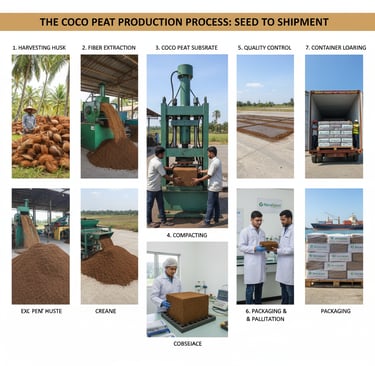The Journey from Coconut Husk to Coco Peat Block: A Sustainable Story
Curious about your growing medium? Trace the eco-friendly journey of coco peat! Learn how NovaXport ensures every compressed block meets global standards through expert washing, buffering, and precise container loading.
10/7/20252 min read


Coco peat, often called coir pith, is one of the world's most versatile and eco-friendly growing mediums. It's the powerhouse behind many successful greenhouses and hydroponic farms globally. But how does the fuzzy husk of a coconut transform into the highly valuable, compressed block we ship to you?
At NovaXport, we manage this process from start to finish with engineering precision and a commitment to sustainability. Here is a look at the detailed journey your premium coco peat block takes:
1. Harvesting the Husk: The Raw Material
The process begins in the lush coconut groves of South India. Once the coconut meat is harvested, the thick, fibrous outer layer—the husk—is separated. This husks, which were once considered waste, are now the raw material for our entire industry, making coco peat a true example of sustainable upcycling.
2. Fiber Extraction (Defibering)
The husks are soaked in water for several months in a process called retting (though modern methods often use machinery to speed this up). Next, the softened husks are fed into defibering machines. These machines separate the long, valuable coir fibers (used for ropes, mats, and brushes) from the finer, sponge-like material—which is the coco peat (or coir pith).
3. Creating the Coco Peat Substrate
The raw coco peat is highly saline and acidic. For it to become a premium growing medium, it must be treated:
Washing & Buffering: The coco peat is rigorously washed with fresh water to lower its Electrical Conductivity (EC), which measures salt content. It is then often buffered with a calcium solution to optimize the pH level, ensuring it is perfect for plant growth.
Drying & Screening: The coco peat is spread out under the tropical sun to dry naturally. Once dry, it passes through fine mesh screens (sifting) to remove any remaining large fibers or impurities, guaranteeing a uniform, clean substrate.
4. Compacting: The Magic Block
Once tested for optimal pH and EC, the fine, loose coco peat is poured into high-pressure hydraulic presses. This step is crucial for efficient global trade:
Coco Peat Compacting: The machines compress the loose material by factors up to 5:1 to form the dense, easily stackable coco peat blocks (or bricks). This massive reduction in volume drastically lowers shipping costs for our international buyers.
5. Quality Control: The Engineering Check
This is where NovaXport’s technical background shines. We utilize our engineering expertise to conduct stringent quality checks before any block is packaged:
Random Batch Testing: Samples from every production run are sent to independent labs to verify the pH, EC, moisture content, and expansion rate.
Physical Inspection: Blocks are checked manually for density, consistent size, and freedom from foreign material.
6. Packaging & Palletization
The approved blocks are individually wrapped in high-quality, durable plastic film (often shrink-wrapped) to protect them from moisture and contamination during transit. They are then palletized—neatly stacked and secured on wooden pallets—ready to withstand the rigors of international shipping.
7. Container Loading: Global Connection
The final step is precisely loading the pallets into shipping containers. Our team uses expert logistical planning to ensure the containers are maximized for payload (getting the most product per container) while securing the cargo perfectly to guarantee the blocks arrive at your international destination in flawless condition.
When you receive a NovaXport coco peat block, you aren't just getting a growing medium; you're getting the end result of a meticulous, quality-controlled, and sustainable export process. We deliver confidence, straight from India's coconut heartland to your business.
